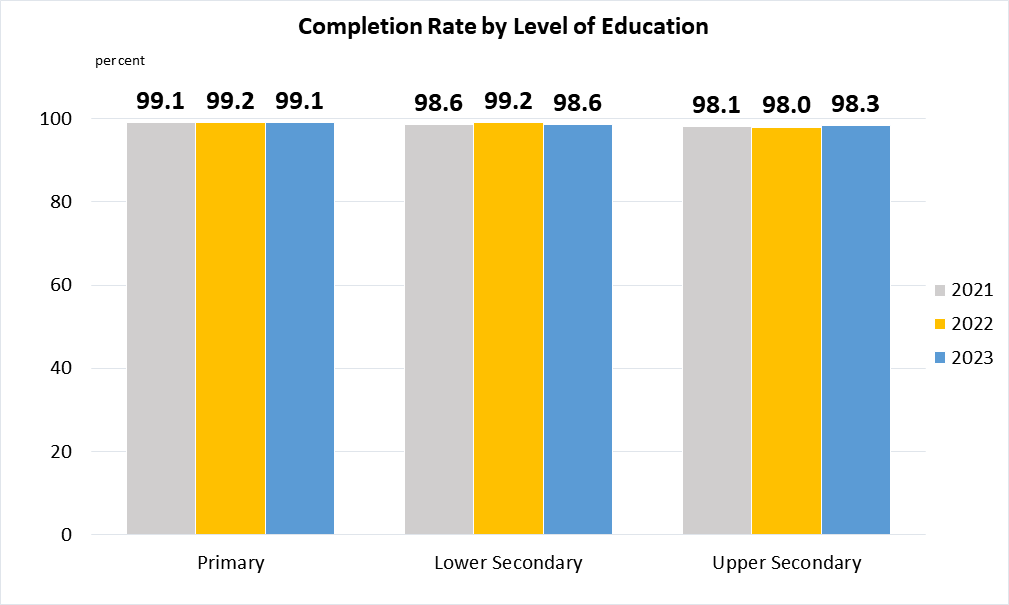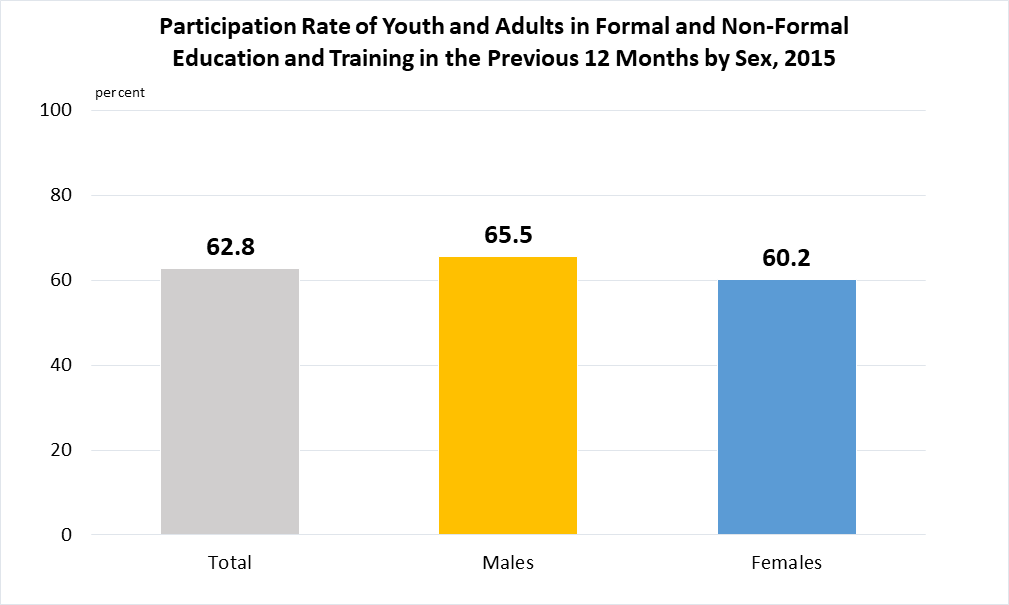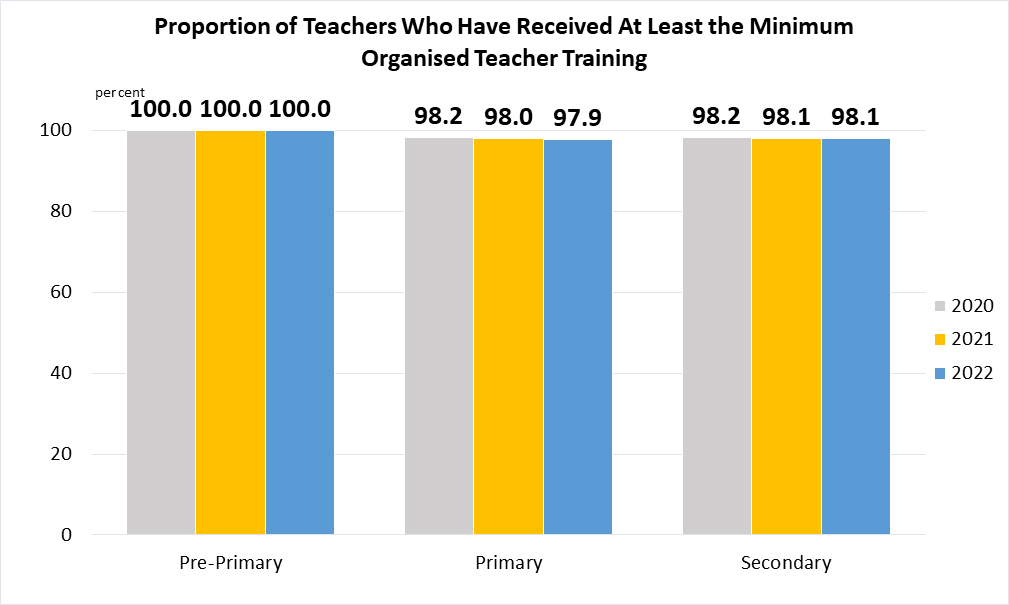Sustainable Development Goals
Targets and Indicators with Data Availability
Note: The data may be updated periodically as more information become available.
 |
Free Primary and Secondary Education
By 2030, ensure that all girls and boys complete free, equitable and quality primary and secondary education leading to relevant and effective learning outcomes.
|
Indicator 4.1.1 | Proportion of children and young people (a) in grades 2/3; (b) at the end of primary; and (c) at the end of lower secondary achieving at least a minimum proficiency level in (i) reading and (ii) mathematics, by sex
|
(bi)

Data are taken from Progress in International Reading Literacy Study (PIRLS) for Grade 4 or Primary 4 students.
(bii)

Data are taken from Trends in International Mathematics and Science Study (TIMSS) for Grade 4 or Primary 4 students.
(ci)

Data are taken from the Programme for International Student Assessment (PISA), targeting 15-year-olds.
(cii)

Data are taken from Trends in International Mathematics and Science Study (TIMSS) for Grade 8 or Secondary 2 students.
|
 |
Indicator 4.1.2 | Completion rate (primary education, lower secondary education, upper secondary education)
|

Data are based on the proportion of Singapore residents (i.e. Singapore citizens and permanent residents) aged 17-19 years with Highest Qualification Attained (HQA) 'Primary & Above' for Primary Completion Rate, aged 19-21 years with HQA 'Lower Secondary & Above' for Lower Secondary Completion Rate, and aged 21-23 years with HQA 'Secondary & Above' for Upper Secondary Completion Rate.
|
 |
|
 |
Equal Access to Quality Pre-Primary Education
By 2030, ensure that all girls and boys have access to quality early childhood development, care and pre-primary education so that they are ready for primary education.
|
Indicator 4.2.2 | Participation rate in organized learning (one year before the official primary entry age), by sex
|

Data refer to Singapore citizen children only.
|
 |
 |
Equal Access to Affordable Technical, Vocational and Higher Education
By 2030, ensure equal access for all women and men to affordable and quality technical, vocational and tertiary education, including university.
|
Indicator 4.3.1 | Participation rate of youth and adults in formal and non-formal education and training in the previous 12 months, by sex
|
(a)

Data are taken from Programme for the International Assessment of Adult Competencies (PIAAC), targeting adults aged 16 - 65.
Please note that this includes students in their regular cycle of studies.
(b)

Data are taken from Programme for the International Assessment of Adult Competencies (PIAAC), targeting adults aged 16 - 65.
Please note that this includes students in their regular cycle of studies.
|
|
 |
 |
Increase the Number of People with Relevant Skills for Financial Success
By 2030, substantially increase the number of youth and adults who have relevant skills, including technical and vocational skills, for employment, decent jobs and entrepreneurship.
|
Indicator 4.4.1 | Proportion of youth and adults with information and communications technology (ICT) skills, by type of skill
|
(a)

Data from 2021 onwards are based on Singapore residents (i.e. Singapore citizens and permanent residents) aged 16-74 years. Data prior to 2021 are based on Singapore residents (i.e. Singapore citizens and permanent residents) aged 15 and above.
(b)

Data from 2021 onwards are based on Singapore residents (i.e. Singapore citizens and permanent residents) aged 16-74 years. Data prior to 2021 are based on Singapore residents (i.e. Singapore citizens and permanent residents) aged 15 and above.
Proportion of Youth and Adults with Information and Communications
Technology (ICT) Skills, by Type of Skill
| Per Cent |
| Year |
2022 |
2023 |
2024 |
|
Using basic arithmetic formula in a spreadsheet |
36.1 |
41.3
|
42.6 |
|
Using copy and paste tools to duplicate or move data, information and content in digital environments (e.g., within a document, between devices, on the cloud) |
54.3
|
57.2 |
60.3 |
|
Reading or downloading newspapers, magazines or electronic books in a digital format |
46.8 |
51.8 |
67.2 |
|
Sending messages (e.g., e-mail, messaging service, SMS) with attached files (e.g., document, picture, video) |
75.6 |
69.8 |
88.0 |
|
Creating electronic presentations with presentation software (including text, images, sound, video or charts) |
37.1 |
44.0 |
46.8 |
|
Doing an online course (in any subject) |
17.9 |
20.7
|
23.5 |
|
Getting information about goods or services online |
63.6 |
65.4 |
86.2 |
|
Purchasing or ordering goods or services using the Internet |
66.6 |
66.1 |
75.8
|
|
Seeking health information (on injury, disease, nutrition, etc.) |
44.0 |
54.3 |
86.2 |
|
Connecting and installing new devices (e.g. a modem, camera, printer) through wired or wireless technologies |
28.1 |
35.9 |
39.7 |
|
Using Internet banking |
78.4 |
75.5 |
85.4 |
|
Using software run over the Internet for editing text documents, spreadsheets or presentations |
31.4 |
37.7 |
54.9 |
|
Programming or coding in digital environments (e.g. computer software, app development) |
6.3 |
10.7
|
13.7 |
|
Changing privacy settings on your device, account or app to limit the sharing of personal data and information (e.g. name, contact information, photos) |
76.1 |
74.4 |
75.6 |
|
Setting up effective security measures (e.g. strong passwords, log-in attempt notification) to protect devices and online accounts |
79.6 |
78.7 |
82.7 |
|
Participating in social networks |
69.9 |
71.5 |
82.2 |
|
Finding, downloading, installing and configuring software and apps |
55.6 |
57.9 |
64.7 |
|
Transferring files or applications between devices (including via cloud-storage) |
52.6 |
54.3 |
54.9 |
|
Uploading self/user-created content to a website to be shared |
43.7 |
41.3 |
53.1 |
|
Making calls (Telephoning over the Internet/VoIP, using Skype, Whatsapp, Viber, iTalk, etc.; includes video calls via webcam) |
65.5 |
75.9 |
87.7 |
|
Verifying the reliability of information found online |
85.0 |
75.2 |
76.7 |
Data from 2021 onwards are based on Singapore residents (i.e. Singapore citizens and permanent residents) aged 16-74 years. Data prior to 2021 are based on Singapore residents (i.e. Singapore citizens and permanent residents) aged 15 and above.
|
|
 |
 |
Eliminate All Discrimination in Education
By 2030, eliminate gender disparities in education and ensure equal access to all levels of education and vocational training for the vulnerable, including persons with disabilities, indigenous peoples and children in vulnerable situations.
|
Indicator 4.5.1 | Parity indices (female/male, rural/urban, bottom/top wealth quintile and others such as disability status, indigenous peoples and conflict-affected, as data become available) for all education indicators on this list that can be disaggregated
|
(a)

Singapore does not compute total net enrolment rate for Tertiary as the age range of tertiary students varies widely.
(b)

|
 |
 |
Universal Literacy and Numeracy
By 2030, ensure that all youth and a substantial proportion of adults, both men and women, achieve literacy and numeracy.
|
Indicator 4.6.1 | Youth/adult literacy rate
|

Data refer to Singapore residents (i.e. Singapore citizens and permanent residents) and are derived based on information as reported in household surveys as well as administrative data.
|
 |
 |
Education for Sustainable Development and Global Citizenship
By 2030, ensure that all learners acquire the knowledge and skills needed to promote sustainable development, including, among others, through education for sustainable development and sustainable lifestyles, human rights, gender equality, promotion of a culture of peace and non-violence, global citizenship and appreciation of cultural diversity and of culture’s contribution to sustainable development.
|
Indicator 4.7.1 | Extent to which (i) global citizenship education and (ii) education for sustainable development are mainstreamed in (a) national education policies; (b) curricula; (c) teacher education; and (d) student assessment
|
Since 2021, the Ministry of Education's Eco Stewardship Programme (ESP) has been implemented in all schools to nurture students to be environmental stewards. As the education pillar of the Singapore Green Plan 2030, the ESP integrates sustainability into curricula across levels and subjects, including in the Humanities, Sciences, Food and Consumer Education and Character and Citizenship Education. This is complemented by school-based initiatives for students to further engage in learning experiences related to sustainability. Schools' campuses are also progressively enhanced with sustainability features that help connect students' lived experiences with their learning. Sustainability is featured in teachers' professional learning roadmap, which includes relevant professional development opportunities such as workshops, learning journeys and work attachments.
|
 |
Build and Upgrade Inclusive and Safe Schools
Build and upgrade education facilities that are child, disability and gender sensitive and provide safe, non-violent, inclusive and effective learning environments for all.
|
Indicator 4.A.1 | Volume of official development assistance flows for scholarships
|

Data refer to primary and secondary levels.
|
 |
 |
Expand Higher Education Scholarships for Developing Countries
By 2020, substantially expand globally the number of scholarships available to developing countries, in particular least developed countries, small island developing States and African countries, for enrolment in higher education, including vocational training and information and communications technology, technical, engineering and scientific programmes, in developed countries and other developing countries.
|
Indicator 4.B.1 | Volume of official development assistance flows for scholarships by sector and type of study
|
Not applicable. Singapore does not receive Official Development Assistance.
|
|
 |
Increase the Supply of Qualified Teachers in Developing Countries
By 2030, substantially increase the supply of qualified teachers, including through international cooperation for teacher training in developing countries, especially least developed countries and small island developing States.
|
Indicator 4.C.1 | Proportion of teachers with the minimum required qualifications, by education level
|

Data refer to trained teachers in Singapore.
Singapore does not disaggregate the secondary school teacher data by lower secondary and upper secondary levels as teachers could teach both levels.
|
 |